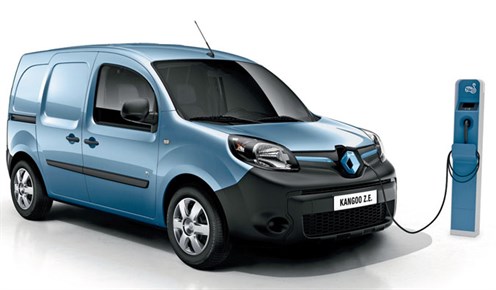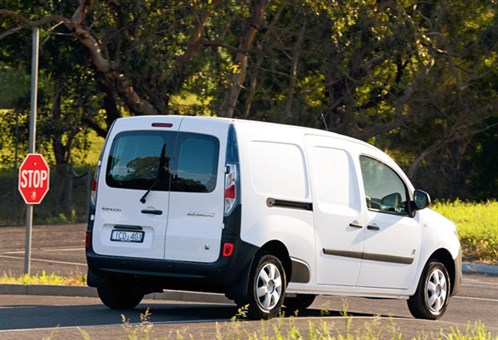Matt Wood takes the Renault Kangoo ZE for a spin to get an idea of what an electric light commercial future could look like.
I had a lot of questions as I descended into the bowels of Renault’s underground car park at the company’s Mulgrave headquarters.
This was to be my first drive of a purely electric vehicle (EV). The Renault Kangoo ZE is not just an EV, it’s also a light commercial vehicle (LCV) and it’s the first of its kind in Australia.
I’d steered a couple of hybrids in the past and come away with mixed feelings, but the sparky little Kangoo was to be the first time I’d mixed it out in the real world running solely on electricity.
Would it be some sort of watered down driving experience? Would it suck the fun out of driving a zippy little Euro van?
Would it be low fat cheddar in place of triple cream brie? Of course the obvious range anxiety question, would I be stuck on the side of a freeway with an empty battery? Is there an optional pedal charger mounted on an exercise bike that lets you get fit and charge your car at the same time? If not should I invent one?
Engine
The little white Kangoo sat in its EV car space looking very smug indeed with a charge cable fastened to its snout.
This didn’t bode well. When plugged into the wall the ZE looks like an intensive care patient on life support. But I needn’t have worried, the cable unfastens with a snap and then it’s simply a matter of turning the key to fire up the Kangoo’s electrical synapses. Renault Australia appears to be taking the future of electric vehicles (EVs) very seriously indeed.
The motive spark is provided by a lithium ion battery that lies under the load area floor.
A 44kW electric motor gets some boogie to the front wheels via a single speed reducer transmission.
As with any commercial vehicle torque is also a factor and the bug-eyed Renault has 260 of Newton’s metres available to haul.
Safety-wise, the Kangoo ZE comes standard with ABS, electronic brake force distribution and emergency brake assist.
Of course, the first question that anyone will ask is “how far can you go?”
The claimed range for the ZE with an underweight supermodel driving and a load of ping-pong balls on board, all accessories turned off and a tail wind is 170km.
Real world conditions are more likely to see a range of between 80 to 120km.
Transmission
The standard automatic transmission shifter lulls you into thinking that you are driving a standard auto; that is until you take your foot off the brake and start to roll backwards on a grade.
This does feel a little weird as the Kangoo ZE looks like an auto, but requires you to have your wits about you on a hill start.
Performance
Two Kangoo Maxi ZE’s are currently on trial with Australia Post, one in Sydney and one in Melbourne. The trial is running over a 12-month period with assistance from Victorian Government Department of Transport, Planning and Local Infrastructure.
At this early stage there isn’t much to glean from trial.
However, we were able to take the ZE for a quick spin through the ’burbs to get an idea on what an electric LCV future could look like.
Initial impressions on climbing in are that it looks exactly the same as any other Kangoo.
A twist of the key lights up the dashboard but results only in a slight background hum when you start to apply power to the ground.
Once out in the traffic, the Kangoo ZE happily pokes along with the rest of the evil, oil-burning punters.
As with most EVs, initial take-off is quite torquey but once up to speed the torque curve has all but disappeared.
Even freeway speeds were an easy ask though I couldn’t help but keep glancing at the effect that my right foot was having on the charge/discharge dial on the dashboard.
Load
On the light commercial side of things the Kangoo ZE also raises an interesting option for inner city, final mile deliveries.
The Kangoo Maxi ZE offers a load area of 4.6 square-metres and a payload of 650kg, 100kg less than its fossil fuel burning Kangoo stablemates.
Today, I was running empty so it’s hard to gauge how the ZE would behave loaded to maximum weight.
It sounds like a cop-out but many LCVs rarely run at their maximum GVM anyway as they tend to cube out first.
Verdict
While the initial punt off the line does seem a little spritely, it’s not a patch on the diesel-burning equivalent performance-wise.
But that’s not really a fair comparison to make; the fossil fuel powered Renault Kangoo and the electric ZE will be bought by very different customers and most likely be put into very different applications.
One thing that all variants of the Kangoo share is that they are all a bit wonky-looking. Luckily they make up for it in road manners.
But out on the road, it’s the silence that really hits you. The Kangoo ZE just hums along serenely, safe in the smug knowledge that it may be the future of inner-city deliveries.
It’s a rather soothing and oddly calming experience. Drivers of the Renault Clio passenger car have the ability to change the sound of the engine note that is funneled into the cab.
I reckon the ZE should also have this feature, some soothing pan pipes or maybe some Tibetan Buddhist throat singing or Gregorian chants to float you through your electrically powered work day.
Perhaps a broken clock spring sound effect if the battery is starting to get too low.
The silence is indeed golden; it’s hard to imaging yelling at some moron who has cut you off because you can actually hear how silly you sound.
This LCV could be the answer to road rage.
There’s also some anecdotal evidence that drivers of EVs in Europe are taking less sick days than drivers of fuel-burning LCVs. Maybe driving an EV is actually good for your health?
Specification
Make/Model: Renault Kangoo ZE
Engine: Synchronous AC electric
Maximum power: 44kW
Maximum torque: 226Nm
Transmission: Single speed reducer
Battery: Lithium ion
Range: 80-125km
Charge time: 6-9 hours
Payload: 650kg






